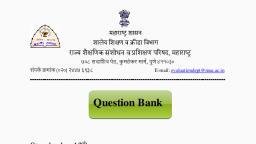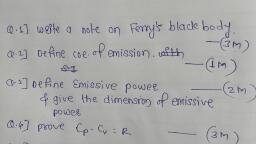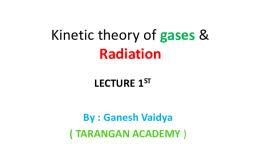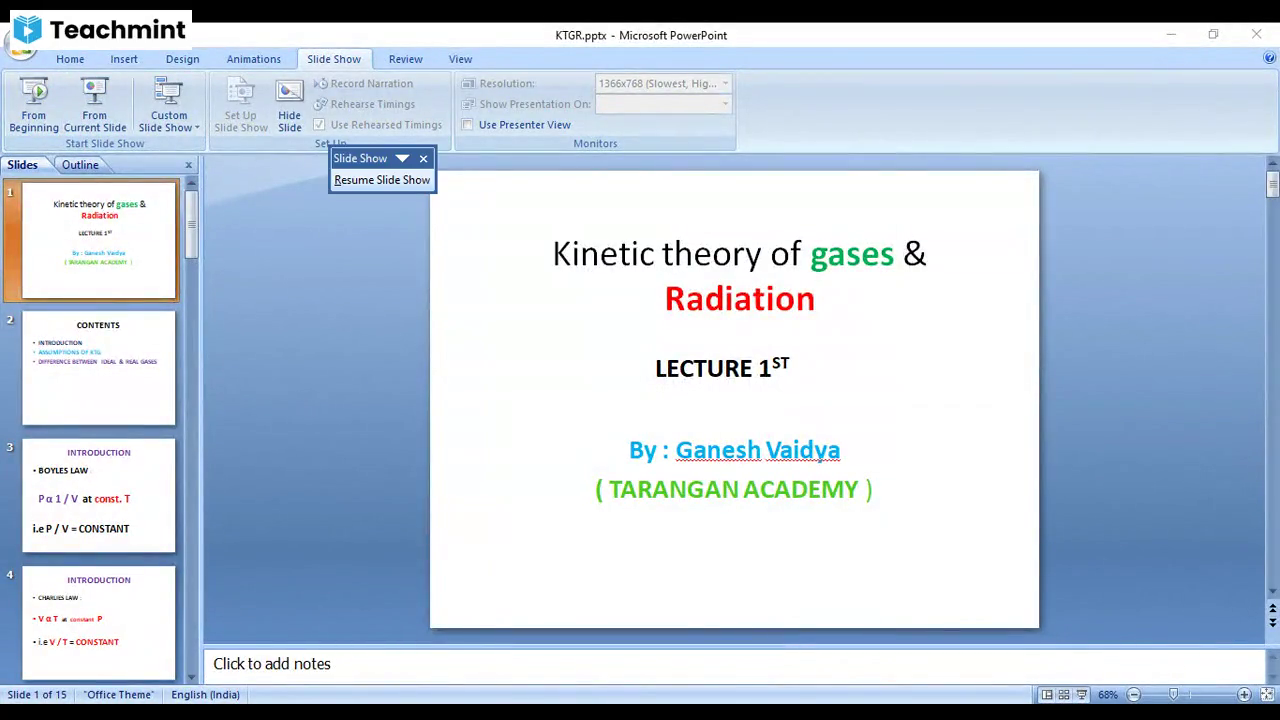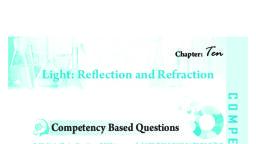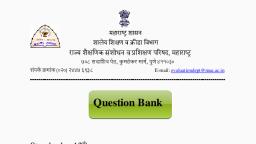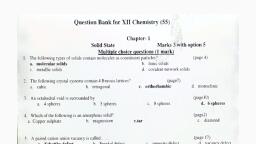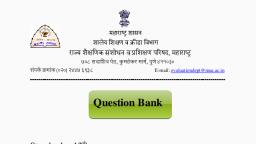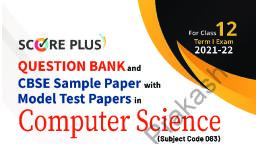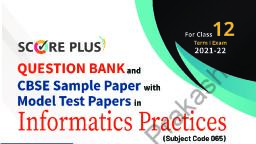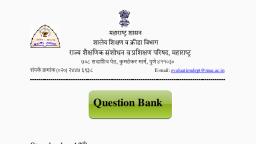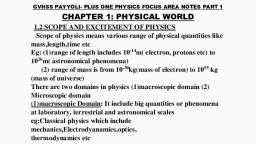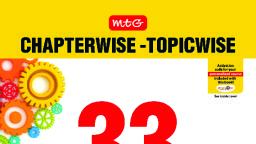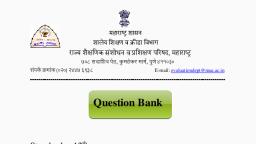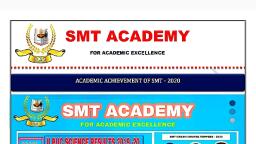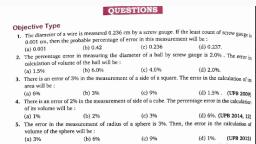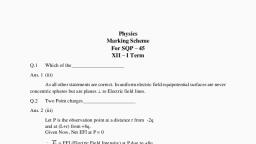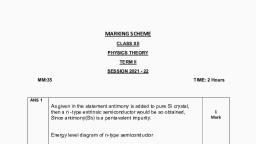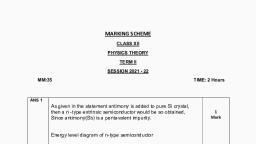Page 2 :
Chapter1. Rotational Dynamics, MCQ’s ( 1 Mark Each), 1. A diver in a swimming pool bends his head before diving. It, a) Increases his linear velocity, b) Decreases his angular velocity, c) Increases his moment of inertia, d) Decreases his moment of inertia, Ans: d) Decreases his moment of inertia, 2. The angular momentum of a system of particles is conserved, a) When no external force acts upon the system, b) When no external torque acts upon the system, c) When no external impulse acts upon the system, d) When axis of rotation remains the same, Ans: b) When no external torque acts upon the system, 3. A stone is tied to one end of a string. Holding the other end, the string is whirled in a, horizontal plane with progressively increasing speed. It breaks at some speed because, a) Gravitational forces of the earth is greater than the tension in string, b) The required centripetal force is greater than the tension sustained by the string, c) The required centripetal force is lesser than the tension in the string, d) The centripetal force is greater than the weight of the stone, Ans: b) The required centripetal force is greater than the tension sustained by the, string, 4. The moment of inertia of a circular loop of radius R, at a distance of R/2 around a, rotating axis parallel to horizontal diameter of the loop is, a) ½ MR2, b) ¾ MR2, c) MR2, d) 2 MR2, Ans: b) ¾ MR2, , 5. A 500 kg car takes a round turn of radius 50m with a velocity of 36 km/hr. The, centripetal force is, a) 250N, b) 750N, c) 1000N, d) 1200N, Ans: c) 1000N
Page 3 :
6. A cyclist riding a bicycle at a speed of 14√3 m/s takes a turn around a circular road of, radius 20√3 m without skidding. Given g = 9.8 m/s2 , what is his inclination to the, vertical, a) 300, b) 450, c) 600, d) 900, Ans: c) 600, , 7. A string of length ℓ fixed at one end carries a mass m at the other. The string makes, 2/π revolutions/sec around the vertical axis through the fixed end.. The tension in the, string is, a) 2 ml, b) 4 ml, c) 8 ml, d) 16 ml, Ans: d) 16 ml, Very Short Answer (VSA) ( 1 MARK Each ), 1. Find the radius of gyration of a uniform disc about an axis perpendicular to its plane, and passing through its center., 2. Does the angle of banking depend on the mass of the vehicle?, 3. During ice ballet, while in the outer rounds, why do the dancers outstretch their arms, and legs, 4. State the principle of conservation of angular momentum., 5. Two bodies have their moments of inertia I and 2I respectively about their axis of, rotation. If their kinetic energies of rotation are equal, then what is the ratio of their, angular velocity., 6. A hollow sphere has radius 6.4 m. what is the minimum velocity required by a motor, cyclist at bottom to complete the circle. (Ans: V=17.7 m/s ), 7. A bend in a level road has a radius of 100m. find the maximum speed which a car, turning this bend may have without skidding, if the coefficient of friction between the, tyres and road is 0.8. (Ans: Vmax= 28 m/s)
Page 4 :
Short Answer I (SA1) ( 2 MARKS Each ), 1. A flywheel is revolving with a constant angular velocity. A chip of its rim breaks and, flies away. What will be the effect on its angular velocity?, 2. The moment of inertia of a uniform circular disc about a tangent in its own plane is, 5/4MR2 where M is the mass and R is the radius of the disc. Find its moment of inertia, about an axis through its centre and perpendicular to its plane., 3. Derive an expression for maximum safety speed with which a vehicle should move, along a curved horizontal road. State the significance of it, 4. The moment of inertia of a body about a given axis is 1.2 kgm 2 . initially the body is, at rest. For what duration on angular acceleration of 25 radian/sec2 must be applied, about that axis in order to produce a rotational kinetic energy of 1500 joule?(Ans:, t=2sec), 5. A bucket containing water is tied to one end of a rope 5 m long and it is rotated in a, vertical circle about the other end. Find the number of rotations per minute in order, that the water in the bucket may not spill. ( Ans: n=13.37 rpm), 6. A body weighing 0.5 kg tied to a string is projected with a velocity of 10 m/s. The, body starts whirling in a vertical circle. If the radius of the circle is 0.8 m, find the, tension in the string when the body is at the top of the circle. (Ans: T= 3.8 N), , Short Answer II (SA2) ( 3 MARKS Each ), 1) Derive an expression for kinetic energy of a rotating body with uniform angular, velocity., 2) Obtain an expression for the torque acting on a rotating body with constant angular, acceleration., 3) Derive an expression for the difference in tensions at highest and lowest point for a, particle performing vertical circular motion., 4) Obtain an expression for the angular momentum of a body rotating with uniform, angular velocity., 5) A railway track goes around a curve having a radius of curvature of 1 km. The, distance between the rails is 1 m. Find the elevation of the outer rail above the inner, rail so that there is no side pressure against the rails when a train goes round the curve, at, , 36 km / hr.(Ans: h = 1.02 cm)
Page 5 :
6) A flywheel of mass 8 kg and radius 10 cm rotating with a uniform angular speed of, 5 rad / sec about its axis of rotation, is subjected to an accelerating torque of 0.01 Nm, for 10 seconds. Calculate the change in its angular momentum and change in its, kinetic energy., (Ans: 0.1kgm2/s,0.625 J), 7) Two wheels of moment of inertia 4 kgm2 rotate side by side at the rate of 120 rev /, min and 240 rev / min respectively in the opposite directions. If now both the wheels, are coupled by means of a weightless shaft so that both the wheels rotate with a, common angular speed. Calculate the new speed of rotation. (Ans: n = 60 rpm), , Long Answer ( LA) ( 4 marks Each), 1) State and explain the theorem of parallel axes., 2) What is a conical pendulum? Obtain an expression for its time period, 3) Obtain an expression for maximum safety speed with which a vehicle can be safely, driven along a curved banked road, OR, Show that the angle of banking is independent of mass of vehicle.
Page 6 :
Chapter 2. Mechanical Properties of fluids, MCQ’s ( 1 Mark Each), , 1) Insect moves over surface of water because of, a) Elasticity, b) Surface tension, c) Friction, d) Viscosity, Ans: b) Surface tension, 2) The water droplets are spherical in free fall due to, a) gravity, b) intermolecular attraction, c) Surface tension, d) Viscosity, Ans: c) Surface tension, 3) Surface tension of a liquid at critical temperature is, a) Infinity, b) Zero, c) Same as any other temperature, d) Can not be determined, Ans: b) Zero, 4) Unit of coefficient of viscosity is, a) Ns/m, b) Ns2/m, c) Ns2/m2, d) Ns/m2, Ans: d) Ns/m2, 5) Two capillary tubes of radii 0.6 cm and 0.3 cm are dipped in the same liquid. The, ratio of heights through which the liquid will rise in the tubes is, a), 2:1, b), 1:2, c), 4:1, d), 1:4, Ans: b) 1:2, 6) The energy stored in a soap bubble of diameter 6 cm and T = 0.04 N/m is nearly, a), b), c), d), , 0.9 × 10-3 J, 0.4 × 10-3 J, 0.7 × 10-3 J, 0.5 × 10-3 J, Ans: a) 0.9 × 10-3 J
Page 7 :
7) Two stones with radii 1:2 fall from a great height through atmosphere. Their terminal, velocities are in the ratio, a) 2:1, b) 1:4, c) 4:1, d) 1:2, Ans: b) 1:4, Very Short Answer (VSA) ( 1 MARK Each ), 1) What is surface film?, 2) What are cohesive forces?, 3) What will be the shape of liquid meniscus for obtuse angle of contact?, 4) What is the net weight of a body when it falls with terminal velocity through a viscous, medium?, 5) A square metal plate of area 100 cm2 moves parallel to another plate with a velocity, of 10 cm/s, both plates immersed in water. If the viscous force is 200 dyne and, viscosity of water is 0.01 poise, what is the distance between them? (Ans: 0.05 cm ), 6) The relative velocity between two parallel layers of water is 8 cm/s and perpendicular, distance between them is 0.1 cm. Calculate the velocity gradient. (Ans:80 per second ), 7) Water rises to a height of 20 mm in a capillary tube. If the radius made 1/3, , rd, , of its, , previous value, to what height will the water now rise in the tube? (Ans: 60 mm ), Short Answer I (SA1) ( 2 MARKS Each ), 1) State properties of an ideal fluid., 2) Compare streamline flow and Turbulent flow., 3) Define surface tension and angle of contact., 4) Calculate the rise of water inside a clean glass capillary tube of radius 0.1 mm, when, immersed in water of surface tension 7 x 10-2 N/m. The angle of contact between, water and glass is zero, density of water is 1000 kg/m 3 , g = 9.8 m/s2, ( Ans: h = 0.1428 m), 5) A rain drop of radius 0.3 mm falls through air with a terminal velocity of 1 m/s. The, viscosity of air is 18 x 10-6 N-s /m2. Find the viscous force on the rain drop., (Ans: F= 1.017 * 10 -7 N), 6) Two soap bubbles have radius in the ratio 2:3. Compare the works done in blowing, these bubbles., (Ans: 4:9)
Page 8 :
Short Answer II (SA2) ( 3 MARKS Each ), 1) Explain the phenomena of surface tension on the basis of molecular theory., 2) Obtain an expression for the capillary rise or fall using forces method., 3) State Stoke’s law and give two factors affecting angle of contact., 4) Twenty seven droplets of water, each of radius 0.1 mm coalesce into a single drop., Find the change in surface energy. Surface tension of water is 0.072 N/m., ( Ans: W= 1.628 X 10 -7 J ), 5) A u-tube is made up of capillaries of bore 1 mm and 2 mm respectively. The tube is, held vertically and partially filled with a liquid of surface tension 49 dyne/cm and, zero angle of contact. Calculate the density of liquid, if the difference in the levels of, the meniscus is 1.25 cm. take g = 980 cm/s 2, ( Ans: density of liquid = 0.8 g/ cm3 ), 6) A rectangular wire frame of size 2 cm x 2 cm, is dipped in a soap solution and taken, out. A soap film is formed, it the size of the film is changed to 3 cm x 3 cm, Calculate, the work done in the process. The surface tension of soap film is 3 x 10-2 N/m., ( Ans: W= 3x 10-5 J ), Long Answer ( LA) ( 4 marks Each), 1) Derive the relation between surface energy & surface tension., 2) Obtain Laplace’s law of spherical membrane, 3) Derive an expression for terminal velocity of the sphere falling under gravity through, a viscous medium., , Chapter 3. Kinetic Theory of gases and Radiation, MCQ’s ( 1 Mark Each), 1) The average energy per molecule is proportional to, (a) the pressure of the gas, , (b) the volume of the gas, , (c) the absolute temperature of the gas, , (d) the mass of the gas, , Ans: c) the absolute temperature of the gas
Page 9 :
2) The number of degrees of freedom, for the vibrational motion of a polyatomic molecule, depends on the, (a) geometric structure of the molecule, , (b) mass of the molecule, , (c) energy of the molecule, , (d) absolute temperature of the molecule, , Ans: a) geometric structure of the molecule, 3) The power radiated by a perfect blackbody depends only on its, (a) material, , (b) nature of surface, , (c) colour, , (d) temperature, , Ans: d) temperature, 4) If the absolute temperature of a body is doubled, the power radiated will increase by a factor, of, (a) 2, , (b) 4, , (c) 8, , (d) 16, , Ans: d) 16, 5) Calculate the value of λmax for radiation from a body having surface temperature 3000 K., (b = 2.897 x 10-3 m K), (a) 9935 Å, , (b) 9656 Å, , (c), , 9421 Å, , (d) 9178 Å, , Ans: b) 9656 Å, 6) The molar specific heat of a gas at constant volume is 12307.69 J kg -1 K-1. If the ratio of the, two specific heats is 1.65, calculate the difference between the two molar specific heats of, gas., (a) 7999 J kg-1 K-1, , (b) 7245 J kg-1 K-1, , (c) 6890 J kg-1 K-1, , (d) 4067 J kg-1 K-1, , Ans: a) 7999 J kg-1 K-1, 7) Calculate the energy radiated in one minute by a blackbody of surface area 200 cm 2 at 127, o, , C (σ = 5.7 x 10-8 J m-2 s-1 K-4), , (a) 1367.04 J, , (b) 1698.04 J, , (c), , 1751.04 J, , (d) 1856.04 J, , Ans: c) 1751.04 J, Very Short Answer (VSA) ( 1 MARK Each ), 1) Under which condition laws of Boyle, Charles, and Gay-Lussac are valid?, 2) On what, the values of absorption coefficient, reflection coefficient and transmission, coefficient depend, in addition to the material of the object on which the radiation is, incident?
Page 10 :
3) Why the temperature of all bodies remains constant at room temperature?, 4) Above what temperature all bodies radiate electromagnetic radiation?, 5) If the density of nitrogen is 1.25 kg/m 3 at a pressure of 105 Pa, find the root mean square, velocity of oxygen molecules. (Ans: Vrms = 489.89 𝑚/𝑠 ), 6) Find kinetic energy of 3 litre of a gas at S.T.P given standard pressure is 1.013 x 10 5 N/m2., (Ans: K.E.= 455.8 𝐽 ), 7), , Determine the pressure of nitrogen at 0 oC if the density of nitrogen at N.T.P. is 1.25, kg/m3 and R.M.S. speed of the molecules at N.T.P. is 489 m/s., (Ans: 𝑃 = 99633.75 N/m), Short Answer I (SA1) ( 2 MARKS Each ), 1) State factors on which the amount of heat radiated by a body depends., 2) Show that for monoatomic gas the ratio of the two specific heats is 5:3., 3) Show that for diatomic gas the ratio of the two specific heats is 7:5., 4) Show the graphical representation of radiant power of a black body per unit range of, wavelength as a function of wavelength., 5) Draw neat labeled diagram of Ferry’s black body., 6) Compare the rate of radiation of metal body at 727 oC and 227 oC., (Ans: 16), 7) 1000 calories of radiant heat is incident on a body. If the body absorbs 400 calories of, heat, find the coefficient of emission of the body. (Ans: a=e=0.4), 8) A metal cube of length 4 cm radiates heat at the rate of 10 J/s. Find its emissive power, at given temperature., (Ans: E = 1041.66 𝐽/𝑠 𝑚 ), Short Answer II (SA2) ( 3 MARKS Each ), , 1) Show that the root mean square speed of the molecules of gas is directly proportional, to the square root of the absolute temperature of the gas., 2) Show that the average energy of the molecules of gas is directly proportional to the, absolute temperature of gas., 3) Calculate the ratio of two specific heats of polyatomic gas molecule., 4) Explain the construction and working of Ferry’s black body.
Page 11 :
5) Compare the rates of emission of heat by a blackbody maintained at 627 oC and at 127, o, , C, if the blackbodies are surrounded by an enclosure at 27 oC. What would be the, , ratio of their rates of loss of heat?, (Ans, , =, , ., , ), , 6) Determine the molecular kinetic energy (i) per mole (ii) per gram (iii) per molecule of, nitrogen molecules at 227 oC, R = 8.310 J mole-1 K-1,No = 6.03 x 1026 moleculesKmole1, , . Molecular weight of nitrogen = 28., , (Ans, (i), , K.E. per mole = 6.232 × 10 J/mole, , (ii), , K.E. per kilogram = 0.225 × 10 J/kg, , (iii), , K.E. per kmole = 1.048 × 10, , J), , 7) The velocity of three molecules, are 2 km s-1, 4 km s-1, 6 km s-1. Find (i) mean square, velocity (ii) root mean square velocity., (Ans, (i), , mean square velocity, 𝑉 = 18.66 km s-1, , (ii), , root mean square velocity, 𝑉, , = 4.319 km s-1), , Long Answer ( LA) ( 4 marks Each), 1) Explain spectral distribution of a blackbody radiation., 2) Derive expression for average pressure of an ideal gas., 3) Derive Mayer’s relation., , Chapter 4. Thermodynamics, MCQ’s ( 1 Mark Each), 1) Which of the following is correct, when the energy is transferred to a system from its, environment?, (a) System gains energy, (b) System loses energy, (c) System releases energy, (d) system does not exchange energy, Ans: a) System gains energy, 2) Which of the following system freely allows exchange of energy and matter with its, environment?, (a) Closed, (b) Isolated, (c) Open, (d) partially closed, Ans: c) Open
Page 12 :
3) Two systems at same temperature are said to be in, (a) chemical equilibrium, (b) thermal equilibrium, (c) mechanical equilibrium, (d) electrical equillibrium, Ans: b) thermal equilibrium, 4) For work done to be reversible, the process should be, (a) cyclic, (b) isobaric, (c) isochoric, Ans: d) adiabatic, , (d) adiabatic, , 5) A gas in a closed container is heated with 10 J of energy. Causing the lid of the container to, rise 2 m with 3 N of force. What is the total change in energy of the system?, (a) 10 J, (b) 4 J, (c) -4 J, (d) - 10 J, Ans: b) 4 J, 6) The second law of thermodynamics deals with transfer of, (a) work done, (b) energy, (c) momentum, Ans: d) heat, , (d) heat, , 7) Heating a gas in a constant volume container is an example of which process?, (a) isochoric, (b) adiabatic, (c) isobaric, (d) cyclic, Ans: c) isobaric, Very Short Answer (VSA) ( 1 MARK Each ), 1) When two objects are said to be in thermal equilibrium?, 2) The science of measuring temperatures is called as?, 3) State zeroth law of thermodynamics., 4) What is energy associated with the random, disordered motion of the molecules of a system, called as ?, 5) A group of objects that can form a unit which may have ability to exchange energy with its, surrounding is called what?, 6) On what basis a thermodynamic system can be classified?, 7) What is a thermodynamic process?, 8) Define heat., 9) What is the internal energy of the system, when the amount of heat Q is added to the system, and the system does not do any work during the process?, 10) When does a system lose energy to its surrounding and its internal energy decreases?, 11) State first law of thermodynamics., 12) A system releases 100 kJ of heat while 80 kJ of work is done on the system. Calculate the, change in internal energy., , (Ans: ∆U = 20 kJ)
Page 13 :
Short Answer I (SA1) ( 2 MARKS Each ), 1) Draw p-V diagram of reversible process., 2) Draw p-V diagram of irreversible process., 3) Draw p-V diagram showing positive work with varying pressure., 4) Draw p-V diagram showing negative work with varying pressure., 5) Draw p-V diagram showing positive work at constant pressure., 6) 3 mole of a gas at temperature 400 K expands isothermally from initial volume of 4, litre to final volume of 8 litre. Find the work done by the gas. (R = 8.31 J mol -1 K-1), ( Ans: W = 6.919 𝑘𝐽 ), 7) An ideal gas of volume 2 L is adiabatically compressed to (1/10)th of its initial volume., Its initial pressure is 1.01 x 105 Pa, calculate the final pressure. (Given 𝛾= 1.4), (Ans: 𝑃 = 25.37 × 10 𝑃𝑎), 8) Explain the cyclic process., 9) Differentiate between reversible and irreversible process., 10) State the assumptions made for thermodynamic processes., , Short Answer II (SA2) ( 3 MARKS Each ), 1) Classify and explain thermodynamic system., 2) Explain given cases related to energy transfer between the system and surrounding –, a. energy transferred (Q) > 0, b. energy transferred (Q) < 0, c. energy transferred (Q) = 0, 3) Explain the different ways through which internal energy of the system can be, changed., 4) Write a note on thermodynamic equilibrium., 5) Explain graphically (i) positive work with varying pressure, (ii) negative work with, varying pressure and (iii) positive work at constant pressure., 6) Write a note on free expansion., 7) One gram of water (1 cm 3) becomes 1671 cm3 of steam at a pressure of 1 atm. The, latent heat of vaporization at this pressure is 2256 J/g. Calculate the external work and, the increase in internal energy., , (Ans. W = 169 J, ∆U = 2087 J)
Page 14 :
8) Calculate the fall in temperature of helium initially at 15 oC when it is suddenly, expanded to 8 times its original volume (𝛾 = 5/3)., , (Ans. – 216.01 oC), , 9) A cylinder containing one gram molecule of the gas was compressed adiabatically, until its temperature rose from 27 oC to 97 oC. Calculate the work done and heat, produced in the gas (𝛾 = 1.5)., , (Ans. W = −11.63 × 10 J and Q = 277 cal), , Long Answer ( LA) ( 4 marks Each), 1) State first law of thermodynamics and derive the relation between the change in, internal energy (∆U), work done (W) and heat (Q)., 2) Explain work done during a thermodynamic process., 3) Explain thermodynamics of isobaric process., 4) Explain thermodynamics of isochoric process., 5) Explain thermodynamics of adiabatic process., , Chapter 5. Oscillations, MCQ’s ( 1 Mark Each), 1) A particle is moving in a circle with uniform speed. Its motion is, a) Periodic and simple harmonic, b) Non periodic, c) Periodic but not simple harmonic, d) Non periodic but simple harmonic, Ans: c) Periodic but not simple harmonic, 2) A particle is performing simple harmonic motion with amplitude A and angular, velocity . the ratio of maximum velocity to maximum acceleration is, a) , b) 1 / , c) 2, d) A / , Ans: b) 1 / , 3) Acceleration of a particle executing S.H.M. at its mean position., a) Is infinity, b) Varies, c) Is maximum, d) Is zero, Ans: d) Is zero
Page 15 :
4) In a second’s pendulum, mass of Bob is 50 g. If it is replaced by 100 g mass, then its, period will be., a) 1 s, b) 2 s, c) 3 s, d) 4 s, Ans: b) 2 s, 5) The maximum speed of a particle executing S.H.M. is 10 m/s and maximum, acceleration is 31.4 m/s2. Its periodic time is, a) 1 s, b) 2 s, c) 4 s, d) 6 s, Ans: b) 2 s, 6) When the displacement of a simple harmonic oscillator is half of its amplitude, its, P.E. is 3 J. Its total energy is, a) 6 J, b) 12 J, c) 15 J, d) 20 J, Ans: b) 12 J, 7) Two S.H.M.’s have zero phase difference and equal amplitudes A. The resultant, amplitude on their composition will be, a) 2 A, b) zero, c) √2 A, d) √2 𝐴, Ans: a) 2 A, Very Short Answer (VSA) ( 1 MARK Each ), 1) A simple pendulum moves from one end to the other in ¼ second. What is its, frequency?, ( Ans: 2 Hz ), 2) A particle executes S.H.M. of 2 cm. At the extreme position, the force is 4 N. What is, the force at a point midway between mean and extreme positions?, ( Ans: F = 2 N ), 3) A simple pendulum is inside a space craft. What will be its periodic time?, ( Ans: infinite ), 4), 5), 6), 7), , What is amplitude of S.H.M., What is seconds pendulum., State the formula for frequency of S.H.M in terms of force constant., What does the phase of /2 indicate in linear S.H.M.?, ( Ans: particle is at the positive extreme position during first oscillation ), Short Answer I (SA1) ( 2 MARKS Each ), , 1) A particle is performing S.H.M. of amplitude 5 cm and period of 2s. Find the speed of, the particle at a point where its acceleration is half of its maximum value., ( Ans: V = 13.6 X 10 -2 m/s )
Page 16 :
2) The acceleration due to gravity on the surface of moon is 1.7 m/s 2. What is the time, period of a simple pendulum on the surface of moon if its time period on the surface of, earth is 3.5 s? ( g on the surface of earth = 9.8 m/s2 ), ( Ans: 8.40 sec ), 3) The total energy of a body of mass 2 kg performing S.H.M. is 40 J. Find its speed while, crossing the centre of the path., ( Ans: V = 6.324 m/s ), 4) Derive differential equation of linear S.H.M., 5) Define linear S.H.M., 6) State any two laws of simple pendulum., Short Answer II (SA2) ( 3 MARKS Each ), 1) The period of oscillation of simple pendulum increases by 20 % , when its length is, increased by 44 cm. find its initial length., ( Ans: L1 = 1 m ), 2) A particle performing S.H.M. has velocities of 8 cm/s and 6 cm/s at displacements of, 3 cm and 4 cm respectively. Calculate the amplitude and period of S.H.M., ( Ans:, , Amplitude = 5 cm, T= 3.14 sec ), , 3) A particle performs linear S.H.M. of period 4 seconds and amplitude 4 cm. Find the, time taken by it to travel a distance of 1 cm from the positive extreme position., ( Ans: t = 0.46 sec ), 4) Obtain an expression for resultant amplitude of , composition of two S.H.M.’s having, same period along same path., 5) Define angular S.H.M. and obtain its differential equation., 6) Obtain the expression for the period of a magnet vibrating in a uniform magnetic field, and performing S.H.M., Long Answer ( LA) ( 4 marks Each), , 1) Using differential equation of linear S.H.M., obtain an expression for acceleration,, velocity and displacement of simple harmonic motion., 2) Define ideal simple pendulum and obtain an expression for its periodic time., 3) Deduce the expression for kinetic energy, potential energy and total energy of a, particle performing S.H.M. State the factors on which total energy depends.
Page 17 :
Chapter 6. Superposition of Waves, MCQ’s (1 Mark Each), 1) A standing wave is produced on a string fixed at one end with the other end free., The length of the string, a. must be an odd integral multiple of λ, b. must be an odd integral multiple of λ/2, c. must be an odd integral multiple of λ/4, d. must be an even integral multiple of λ, Ans: c) must be an odd integral multiple of λ/4, 2) The equation of a simple harmonic progressive wave is given by,, y = 5 cos π [200t – x/150], where x and y are in cm and ‘t’ is in second. Then the, velocity of the wave is, a) 2 m/s, b) 150 m/s, Ans: c) 200 m/s, , c) 200 m/s, , d) 300 m/s, , 3) A man standing unsymmetrical position between two mountains and fires a gun. He, hears the first echo after 1.5 s and the second echo after 2.5 s. If the speed of sound, in air is 340 m/s, then the distance between the mountains will be, a. 400 m, b. 520 m, c. 640 m, d. 680 m, Ans: d) 680 m, 4) A set of tuning forks is arranged is ascending order of frequencies each tuning fork, gives 8 beats/s with the preceding one. If frequency of the first tuning fork is 120, Hz and the last fork is 200 Hz, then the number of tuning forks arranged will be,, a. 8, b. 9, c. 10, d. 11, Ans: d) 11, 5) In law of tension, the fundamental frequency of vibrating string is,, a. inversely proportional to square root of tension, b. directly proportional to the square of tension, c. directly proportional to the square root of tension, d. inversely proportional to density, Ans: c) directly proportional to the square root of tension, 6) The integral multiple of fundamental frequencies are, a. beats, b. resonance, c. overtones, d. harmonics, Ans: d) harmonics
Page 18 :
7) An organ pipe of length 0.4 m is open at both ends. The speed of sound in air is 340, m/s. The fundamental frequency is,, a. 405 Hz, b. 415 Hz, c. 425 Hz, d. 435 Hz, Ans: c) 425 Hz, Very Short Answer (VSA) ( 1 MARK Each ), 1) A wave is represented by an equation y = A Sin(Bx + Ct). Given that the constants A,, B and C are positive, can you tell in which direction the wave is moving?, 2) Why wave motion is doubly periodic?, 3) What is interference of sound waves?, 4) What are beats?, 5) What are harmonics?, 6) What are overtones?, 7) State law of length., 8) State law of tension., 9) State law of linear density., 10) What is the resonance?, 11) What are forced vibrations?, 12) A violin string vibrates with fundamental frequency of 510 Hz. What is the frequency, of first overtone? ( Ans: n1 = 1020 Hz ), 13) A string 1 m long is fixed at one end. The other end is moved up and down with, frequency 20 Hz. Due to this, a stationary wave with four complete loops, gets, produced on the string. Find the speed of the progressive wave which produces the, stationary wave. [Note: Remember that the moving end is a antinode.] ( Ans: V = 10, m/s ), Short Answer I (SA1) ( 2 MARKS Each ), 1) For a stationary wave set up in a string having both ends fixed, what is the ratio of the, fundamental frequency to the third harmonic?, 2) What are stationary waves? Why are they called stationary wave?, 3) Distinguish between overtone and harmonic., 4) State any four applications of beats.
Page 19 :
5) Prove that a pipe open at both end of length of 2L, has same fundamental frequency, as another pipe of closed at one end of length L., 6) How the frequency of vibrating wire is affected, if the load is fully immersed in, water?, 7) A sonometer wire of length 1 m is stretched by a weight of 10 kg. The fundamental, frequency of vibration is 100 Hz. Determine the linear density of material of wire., (Ans: m = 0.0025 × 10-4 kg/m), Short Answer II (SA2) ( 3 MARKS Each ), 1) Find the amplitude of the resultant wave produced due to interference of two, waves given as,, y1 = A1 sin ωt, y2 = A2 sin (ωt + ϕ), 2) Show that even as well as odd harmonics are present as overtone in modes of, vibration of string., 3) State and explain laws of vibrating strings., 4) Two wires of the same material and same cross section are stretched on a sonometer., One wire is loaded with 1 kg and another is loaded with 9 kg. The vibrating length of, first wire is 60 cm and its fundamental frequency of vibration is the same as that of, the second wire. Calculate vibrating length of the other wire. (Ans: 3), 5) The equation of simple harmonic progressive wave is, y = sin π/2 (4t/0.025 – x/0.25)., Where all quantities are in S.I. system. Find amplitude, frequency, wavelength and, velocity of wave. (Ans: Amplitude, A = 1 m Frequency n = 40 Hz Wavelength λ = 1, m,, , v = 40 m/sec, , 6) A stretched sonometer wire is in unison with a tuning fork. When the length is, increased by 4%, the number of beats heard per second is 6. Find the frequency of the, fork., (Ans: n1 = 156 Hz), Long Answer ( LA) ( 4 marks Each), 1) Explain the formulation of stationary waves by analytical method. What are nodes, and antinodes? Show that the distance between two successive nodes or antinodes is, λ/2., 2) Explain the production of beats and deduce analytically the expression for beats, frequency.
Page 20 :
3) State and verify the laws of vibrating strings using sonometer., 4) Waves produced by two vibrators in a medium have wavelength 2 m and 2.1 m, respectively. When sounded together they produce 8 beats/second. Calculate wave, velocity and frequencies of the vibrators. (Ans: n1 = 168 Hz), , Chapter 7. WAVE OPTICS, MCQ’s ( 1 Mark Each), 1) When light travels from an optically rarer medium to an optically denser medium, the, speed decreases because of change in:, a) Wavelength, b) Frequency, c) Amplitude, d) Phase, Ans – a) Wavelength, 2) Light of wavelength 5000 A.U. falls on a plane reflecting surface. The frequency of, reflected light is…, a) 6 x 1014Hz, b) 5 x 1014Hz, c) 2 x 1014Hz, d) 1.666 x 1014Hz, Ans – a) 6 x 1014Hz, 3), a), b), c), d), , Light follows wave nature because…, Light rays travel in a straight line, Light exhibits the phenomenon of reflection and refraction, Light exhibits the phenomenon of interference, Light causes the phenomenon of photoelectric effect, Ans – c) Light exhibits the phenomenon of interference, , 4), Young’s double slit experiment is carried out using green, red and blue light, one, colour at a time. The fringe widths recorded are WG, WR, and WB respectively then…, a) WG > WB > WR, b) WB > WG > WR, c) WR > WB > WG, d) WR> WG > WB, Ans – d) WR> WG > WB
Page 21 :
5) The path difference between two waves meeting at a point is (11/4)λ. The phase, difference between the two waves is…, a), b), c), d), , 11 π/4, 11 π/2, 11 π, 22 π, , Ans – b) 11 π/2, 6), a), b), c), d), , Which of the following cannot produce two coherent sources?, Lloyd’s mirror, Fresnel biprism, Young’s double slit, Prism, , Ans – d) Prism, 7), a), b), c), d), , The bending of beam of light around corners of obstacle is called…, Reflection, Diffraction, Refraction, Interference, , Ans – b) Diffraction, 8) In a single slit diffraction pattern, first minima obtained with red light of wavelength, 6600 A.U. coincides with first maxima f some other wavelength λ then is…, a) 5500 A.U., b) 5000 A.U., c) 4800 A.U., d) 4400 A.U., Ans – d) 4400 A.U., Very Short Answer (VSA) ( 1 MARK Each ), 1) What is the shape of the wave front on Earth for Sunlight?, 2) In Young’s double slit experiment, if there is no initial phase difference between the light, from the two slits, a point on the screen corresponds to the 5 th minimum. What is the path, difference?, 3) Two coherent sources whose intensity ratio is 25:1 produce interference fringes. Calculate, the ratio of amplitudes of light waves coming from them.
Page 22 :
4) Why two light sources must be of equal intensity to obtain a well-defined interference, pattern?, 5) What is the relation between phase difference and Optical path in terms of speed of light in, vacuum?, 6) What should be the slit width to obtain pronounced diffraction with a single slit, illuminated, by light of wavelength λ?, 7)What must be ratio of the slit width to the wavelength for a single slit, to have the first, diffraction minimum at 45˚?, , Short Answer I (SA1) ( 2 MARKS Each ), 1) What are Secondary sources? State Huygens’ Principle., 2) A Plane Wavefront of light of wavelength 5500 A.U. is incident on two slits in a, screen perpendicular to the direction of light rays. If the total separation of 10 bright, fringes on a screen 2 m away is 2 cm. Find the distance between the slits., ( Answer : d =5.5 x 10-4m), 3) State any four Conditions for Obtaining well – defined and Steady Interference, Pattern., 4) Draw a neat labelled ray diagram of Fresnel Biprism experiment showing the region, of interference., 5) What is Optical Path length? How is it different from actual Path length?, 6) What is difference between Fresnel and Fraunhofer diffraction?, 7) Compare Young’s Double Slit Interference Pattern and Single Slit Diffraction Pattern., 8) White light consists of wavelengths from 400 nm to 700 nm. What will be the, wavelength range seen , When white light is passed through glass of refractive index, 1.55 ? (Ans: (258.1 to 451 nm )
Page 23 :
9) The Optical Path of a ray of light of a given wavelength travelling a distance of 3 cm, in flint glass having refractive index 1.6 is same as that on travelling a distance x cm, through a medium having refractive index 1.25. Determine the value of x., (Ans: 3.84 cm ), Short Answer II (SA2) ( 3 MARKS Each ), 1) Explain reflection of light at a plane surface with the help of a neat ray diagram., 2) Describe Young’s double slit experiment with a neat diagram showing points of maximum, and minimum intensity., 3) Explain experimental setup for Fraunhofer diffraction with neat diagram., 4) The distance between two bright fringes in a biprism experiment using light of wavelength, 6000 A.U. 0.32 mm. By how much will the distance change, if light of wavelength, 4800 A.U., , is used?, , ( Ans: Change in distance x = 0.06 mm), 5) A parallel beam of green light of wavelength 546 nm passes through a slit of width 0.4mm., The intensity pattern of the transmitted light is seen on a screen which is 40 cm away., What is the distance between the two first order minima?, (Ans : We = 1mm), 6) In Fraunhofer diffraction by a narrow slit, a screen is placed at a distance of 2 m from the, lens to obtain the diffraction pattern. If the slit width is 0.2mm and the first minimum is, 5mm, on either side of central maximum. Find the wavelength of light., ( Ans: 5000 A.U.), Long Answer ( LA) ( 4 marks Each), 1) Describe geometry of the Young’s double slit experiment with the help of ray, diagram. What is fringe width? Obtain an expression of it. Write the conditions for, constructive as well as destructive interference.
Page 24 :
2) Explain Fraunhofer diffraction at a single slit with neat ray diagram. Obtain, expression for width of the central bright fringe., 3) What is interference? Explain constructive and destructive interference with the help, of diagram. What are coherent sources of light?, Chapter 8. Electrostatics, MCQ’s ( 1 Mark Each), 1) A metal foil of negligible thickness is introduced between two plates of a capacitor at, the centre. The capacitance of capacitor will be, a) Half, b) Double, c) Same, d) K times, Ans: c) Same, 2) Capacitance (in F) of a spherical conductor of radius 1m is, a) 1.1 x 10-10, b) 9 x 10-9, c) 10-6, d) 10-3, Ans: a) 1.1 x 10-10, 3) A dipole is placed in a uniform electric field, its potential energy will be minimum when, the angle between its axis and field is, a) 2π, b) π, c), d) Zero, Ans: d) Zero, 4) If an electron is brought towards another electron, the electric potential energy of the, system, a) decreases, b) increases, c) Becomes zero, d) Remains same, Ans: b) increases, 5) The work done in carrying a charge Q once round a circle of radius r with charge q at, the centre of the circle is, a), b), , ., .
Page 25 :
c) Zero, ., , d), , Ans: c) Zero, 6) You are given a number of capacitors labelled as 8μF - 250V. Find the number of, capacitors needed to get an arrangement equivalent of 16μF - 1000V., a) 4, b) 16, c) 32, d) 64, Ans: c) 32, 7) A parallel plate capacitor with oil between the plates (dielectric constant of oil, k = 2), has a capacitance C. If the oil is removed, then the capacitance of the capacitor becomes, a) 2C, b) 𝐶 √2, c), , √, , d), Ans: d), Very Short Answer (VSA) ( 1 MARK Each ), 1. What do you mean by dielectric polarization?, 2. Which physical quantity has its unit as J/C? Is it a scalar or vector?, 3. What are linear isotropic dielectrics?, 4. What happens to the energy stored in a capacitor, if the plates of a charged capacitor, are drawn apart, the battery remaining connected?, 5. The mean free path of electrons in a metal is 4 x 10 -8m. Find the electric field , in units, of V/m, which can give on an average 2 eV energy to an electron in the metal., (Ans: E = V / d = 5 x 107 V/m), 6. Find the electric potential at the surface of an atomic nucleus(Z=50) of radius 9ⅹ10 -13, cm., (Ans: V = 8 x 106 V), 7. The capacity of a parallel plate capacitor is 10 μF when the distance between its plates, is 9 cm. What will be its capacity if the distance between the plates is reduced by 6 cm., (Ans: C2 = 30μF)
Page 26 :
Short Answer I (SA1) ( 2 MARKS Each ), 1) Explain the principle of a capacitor., 2) Obtain an expression for the electric field intensity at a point outside uniformly, charged infinite plane sheet., 3) What are polar and non polar dielectrics., 4) Two capacitors each of capacity 2 μF are connected in parallel. This system is, connected in series with a third capacitor of 12μF capacity. Find the equivalent, capacity of the system. ( Ans: 3µF), 5) Two spheres A and B of radius a and b respectively are at the same potential. Find the, ratio of the surface charge densities of A and B., (Ans:, , = b/a ), , 6) A molecule with a dipole moment p is placed in an electric field of strength E. Initially, the dipole is aligned parallel to the field. If the dipole is to be rotated to be anti-parallel, to the field,find the work required to be done by an external agent., (Ans: W = 2pE), Short Answer II (SA2) ( 3 MARKS Each ), 1) Derive an expression for the effective capacitance of three parallel plate capacitors, connected in series., 2) Obtain an expression for the energy stored in a charged condenser . Express it in, different forms., 3) Obtain an expression for the capacitance of a parallel plate capacitor without a, dielectric ., 4) Two parallel plate capacitors X and Y have the same area of the plates and same, separation between them, are connected in series to a battery of 15 V. X has air, between the plates while Y contains a dielectric of constant k = 2., i) Calculate the capacitance of each capacitor if equivalent capacitance of the, combination is 2 μF. ii) Calculate the potential difference between the plates of X and, Y. iii)What is the ratio of the electrostatic energy stored in X and Y?, (Ans: i) Cx = 3μF, , Cy= 6μF,, , ii) Vx = 10 V Vy = 5 V, , iii) Energy stored (x) / Energy stored (y) = 2 : 1 )
Page 27 :
5) Find the amount of work done in rotating an electric dipole of dipole moment 3.2 x 10 8, , Cm from its position of stable equilibrium to the position of unstable equilibrium in a, , uniform electric field if intensity 104 N / C. (Ans: 6.4 x 10 -4 J), 6) Three point charges +q, +2q and Q are placed at the three vertices of an equilateral, triangle. Find the value of charge Q (in terms of q), so that electric potential energy of, the system is zero., ( Ans: Q = -2q / 3 ), Long Answer ( LA) ( 4 marks Each), 1) Obtain an expression for the potential energy of a dipole in an external field., 2) Find the capacitance of a parallel plate capacitor with dielectric slab between the plates., 3) Derive an expression for the electric potential due to an electric dipole., , Chapter 9. CURRENT ELECTRICITY, MCQ’S (1 Mark Each), 1) Kirchhoff’s second law (voltage law) is based on, a) conservation of charge, b) conservation of mass, c) conservation of energy, d) conservation of momentum, Ans: c) conservation of energy, , 2) When unknown resistance is determined by meter bridge, the error due to contact resistance, is minimised by, a) connecting both the resistances only in one gap, b) interchanging the position of known and unknown resistances, c) using uniform wire, d) obtaining the null point near the ends of the wire, Ans: b) interchanging the position of known and unknown resistances.
Page 28 :
3) The SI unit of potential gradient is, a) V/cm, , b) V-m, , c) V/m, , d) V-cm, , Ans: c) V/m, , 4) Instrument which can measure terminal potential difference as well as electromotive force, (emf) is, a) Wheatstone’s meter bridge, b) voltmeter, c) potentiometer, d) galvanometer, Ans: c) potentiometer, , 5) When null point is obtained in the potentiometer, the current is drawn from the, a) main battery, b) cell battery, c) both main and cell battery, d) neither main nor cell battery, Ans: a) main battery, , 6) If potential gradient of a wire decreases, then its length, a) remains constant, b) decreases, c) increases, d) none of the above, Ans: c) increases, 7) Four resistances 4 Ω,8Ω, XΩ and 12Ω are connected in a series to form Wheatstone’s, network. If the network is balanced, the value of X is, a) 24, , b) 18, , c) 12, , d) 8, , Ans: a) 24
Page 29 :
Very Short Answer (VSA) ( 1 MARK Each ), 1) State Kirchhoff’s first (current) law., 2) State Kirchhoff’s second (voltage) law., 3) What is the basis of Kirchhoff’s current law and voltage law?, 4) Are Kirchhoff’s laws applicable to both AC and DC circuits?, 5) Define potential gradient., 6) On what factors does the potential gradient of the wire depend?, 7) What is the SI unit of potential gradient?, 8) State any one use of a potentiometer., 9) A voltmeter has resistance of 100 Ω. What will be its reading when it is connected, across a cell of emf 6 V and internal resistance 20 Ω? (Ans: 5 V), 10) In a meter bridge, two unknown resistances R and S, when connected between the two, gaps, gives a null point is 60 cm from one end. What is the ratio of R and S?, (Ans: 3/2 ), Short Answer I (SA1) ( 2 MARKS Each ), 1. What are the disadvantages of a potentiometer over a voltmeter?, 2. Distinguish between a potentiometer and a voltmeter., 3. Distinguish between an ammeter and a voltmeter., 4. How do you calculate the shunt required to increase the length small n times?, 5. Define: a) electrical circuit b) Junction, 6. Calculate the value of the shunt resistance when connected across a galvanometer of, resistance 18Ω will allow 1/10 th of the current to pass through the galvanometer., (Ans: S = 2Ω), 7. Four resistances 6Ω,6Ω,6Ω and 18Ω form a Wheatstone bridge. Find the resistance, which connected across the 18Ω resistance will balance the network. (Ans: 9 Ω), 8., , The maximum safe voltage that can be measured using a galvanometer of resistance G, is Vm . Find the resistance to be connected in series with the galvanometer so that it, becomes a voltmeter of range nVm. [ Ans: (n-1) G ]
Page 30 :
Short Answer II (SA2) ( 3 MARKS Each ), 1) Explain with a neat circuit diagram. How you will determine the unknown resistances, using a meter bridge., 2) State any two sources of errors in the metre bridge experiment. Explain how they, can be minimised., 3) What is potential gradient? How is it measured? Explain., 4) Describe how a potentiometer is used to compare the emf’s of two cells by connecting, the cells individually., 5) A cell of e.m.f 1.5V and negligible internal resistance is connected in series with a, potential meter of length 10 m and total resistance 20 Ω. What resistance should be, introduced in the resistance box such that the potential drop across the potentiometer, is one microvolt per cm of the wire? 3 ( Ans : 29980 Ω ), 6) In a meter bridge, the balance point is found to be at 39.5 cm from the end A when the, resistor R is of 12.5 Ω (right gap). a) Determine the resistance of X (left gap). b), Determine the balance point of the bridge if X and R are interchanged? c) What, happens if the galvanometer and cell are interchanged at the balance point of the, bridge?, (Ans: a) 8.16 Ω b) 60.5 cm ), 7) The emf of a standard cell is 1.5V and is balanced by a length of 300 cm of a, potentiometer with 10 m long wire. Find the percentage error in a voltmeter which, balances at 350 cm when its reading is 1.8 V. 3 (Ans : 2.8571 % ), , Long Answer ( LA) ( 4 marks Each), 1) Describe with the help of a neat circuit diagram how you will determine the internal, resistance of a cell by using a potentiometer. Derive the necessary formula., 2) Describe how a potentiometer is used to compare the emf’s of two cells by the, combination method., 3) State the uses of a potentiometer. Why is a potentiometer preferred over a voltmeter, for measuring emf?
Page 31 :
Chapter 10. Magnetic Effect of Electric Current, MCQ’S (1 Mark Each), 1) According to right hand rule, the direction of magnetic induction if the current is directed, in anticlockwise direction is, (a) perpendicular and inwards (b) perpendicular and outwards, (c) same as current, , (d) opposite to that of current, , Ans: b) perpendicular and outwards, 2) A conductor has three segments; two straights of length L and a semicircular with radius, R. It carries a current I What is the magnetic field B at point P?, , (𝑎), , (c), , (𝑏), , (d), , Ans: a), , 3) A strong magnetic field is applied on a stationary electron. Then the electron, (a) moves in the direction of the field, , (b) remained stationary, , (c) moves perpendicular to the direction of the field (d) moves opposite to the direction of the, field, , Ans: b) remained stationary., 4) The force between two parallel current carrying conductors is F. If the current in each, conductor is doubled, then the force between them becomes, (a) 4F, , (b) 2F, , (c) F, , (d) F/4, , Ans: a) 4F, 5) Which, , of the following is not a unit of magnetic induction?, , (a) guass, , (b) tesla, , (c) oersted, , Ans: c) oersted, 6) The magnetic dipole moment of current loop is independent of, (a) number of turns, , (b) area of loop, , (c) current in the loop, , (d) magnetic field in which it is lying, , Ans: d) magnetic field in which it is lying, , (d) Wb/m2
Page 32 :
7) Circular loop of radius 0.0157 m carries a current 2 A. The magnetic field at the centre of, the loop is, (a) 1.57 × 10-3 Wb/m², Ans: (b) 8.0 × 10-5, , (b) 8.0 × 10-5 Wb/m², , (c) 2.0 × 10-3 Wb/m2, , (d) 3.14 × 10-1 Wb/m², , Wb/m², Very Short Answer (VSA) ( 1 MARK Each ), , 1) What is Lorentz force?, 2) What is Solenoid?, 3) What is Toroid?, 4) Calculate the value of magnetic field at a distance of 2 cm from a very long straight wire, carrying a current 5 A, 5) What happens to the magnetic field at the centre of a circular current carrying coil if we, double the radius of the coil keeping the current unchanged?, 6)A solenoid of length 50 cm of inner radius of 1 cm and is made up of 500 turns of copper, wire for a current of 5 A in it. What will be magnitude of magnetic field inside the, solenoid?, 7) State the orientation of magnetic dipole with respect to magnetic field, which possess, maximum magnetic potential energy, Short Answer I (SA1) ( 2 MARKS Each ), 1) A toroid of 4000 turns has outer radius of 26 cm and inner radius of 25 cm. If the current in, the wire is 10 A. Calculate the magnetic field of the toroid., , [ Ans: 3.137 x 10 -2 T], , 2) Magnetic field lines can be entirely confined within the core of a toroid, but not within a, straight solenoid Why?, 3) A solenoid of length π m and 5 cm in diameter has winding of 1000 turns and carries a, current of 5 A. Calculate the magnetic field at its centre along the radius. [ Ans : 2 x 10 -3 T], 4) Currents of equal magnitude pass through two long parallel wires having separation of 1.35, cm. If the force per unit length on each wire is 4.76 x 10 -2 N/m, what is I ?, [ Ans: 56.68 A]
Page 33 :
5) Explain " Magnetic force never does any work on moving charges" ., 6) State the conditions when magnetic potential energy of a magnetic dipole (current carrying, coil) kept in uniform magnetic field be minimum and maximum., 7) Derive the expression for magnetic field produced by a current in a circular arc of wire, , Short Answer II (SA2) ( 3 MARKS Each ), 1) Explain Construction and working of Moving coil Galvanometer., 2) Explain Biot Savart's Law, 3) A Rectangular coil of 10 turns, each of area 0.05 m 2, is suspended freely in a uniform, magnetic field of induction 0.01 T. A current of 30 µA is passed through it. (i) What, is the magnetic moment of the coil (ii) What is the maximum torque experienced by, the coil?, [ Ans: 15 µA.m2, 1.5 x10-7 N.m ], 4) Using Ampere's Law, derive an expression for the magnetic induction inside an ideal, solenoid carrying a steady current., 5) Derive an expression for the net torque on a rectangular current carrying loop placed, in a uniform magnetic field with its rotational axis perpendicular to the field., 6) A circular loop of radius 9.7 cm carries a current 2.3 A. Obtain the magnitude of the, magnetic field (i) at the centre of the loop (ii) at a distance of 9.7 cm from the centre, of the loop but on the axis. [Ans: 14.9 µT, 5.267 µT], 7) The magnetic field at the centre of a circular loop of radius 12.3 cm is 6.4 x 10 -6 T., What will be the magnetic moment of the loop? [Ans: 5.954 x 10-2 A m2 ], Long Answer ( LA) ( 4 marks Each), 1) Show that currents in two long, straight, parallel wires exert forces on each other., Derive the expression for the force per unit length on each conductor., 2) Using Biot Savarts law, obtain the expression for the magnetic induction near a, straight infinitely long current carrying wire., 3) Derive an expression for axial magnetic field produced by current in a circular loop.
Page 34 :
Chapter 11. Magnetic materials, MCQ’S (1 Mark Each), 1), , The magnetic susceptibility is given by, a) χ =, , b) χ =, , c) χ =, , d) χ =, , Ans, , : d) χ =, , 2), , The relation between relative permeability and magnetic susceptibility is given by, a) χ = µ + 1, , Ans, , b) χ = −µ −1, , c) µ = 1 − 𝜒, , d) µ = 1 + 𝜒, , : d) µ = 1 + 𝜒, , 3), If an electron of charge (-e) and mass 𝑚 revolves around the nucleus of an atom, having, orbital magnetic moment 𝑚 ,then angular momentum of electron is, a), , b) 𝐿 =, , 𝐿=, , c) 𝐿 =, , d) 𝐿 =, , Ans : c) 𝐿 =, 4), If 𝑚 and L denote the orbital angular moment and the angular momentum of the, electron, due to its orbital motion, then the gyromagnetic ratio is given by, a), , b), , c) 𝐿𝑚, , d), , Ans, , :, , 5), , Relative permeability of iron 5500,then its magnetic susceptibility will be, a), , b), , 5500 × 10, , b) 5501 c), , 5499, , d), , 5500× 10, , Ans : c) 5499 , hint : χ = µ − 1, 6), , What is magnetization of a bar magnet having length 6 cm and area of cross section, 5 𝑐𝑚 ?, (𝑚, , = 1), , 𝑎)1.2 × 10, , A/m, , b) 3.3 × 10 A/m, , c) 1.25 × 10, , A/m, Ans :, , b) 3.3× 10 A/m ,, , M=, , =, , A/m, , d) 3.3 × 10
Page 35 :
7), , A magnetic material of susceptibility 3 × 10 , and magnetic intensity is 4 × 10, A𝑚 .Then, The magnetization in the units of A𝑚, a) 12 × 10, , Ans, , : a) 12 × 10, , b), , is, c) 0.75 × 10, , 1.33 × 10, , d) 14 × 10, , , M =χH, , Very Short Answer (VSA) ( 1 MARK Each ), , 1. Give gyro magnetic ratio., 2. What is stated in term of Bohr magneton., 3. Define magnetization, 4. What does the ratio of magnetization to magnetic intensity indicates?, 5. The relative permeability of a medium is 0.075. What is its magnetic susceptibility ?, (Ans : 0.925 , hint : χ = µ − 1), 6. The moment of a magnet ( 15 cm× 2𝑐𝑚 × 1𝑐𝑚 ) is 1.2 A-𝑚 .What is its intensity of, magnetization? (Ans : 𝑀 = 4 × 10 A𝑚, , ), , 7. The electron in hydrogen atom is moving with a speed of 2.5 × 10 m/s in an orbit of, radius 0.5 𝐴° . What is the Magnetic moment of the revolving electron . (Ans : 𝑚 =, = 10, , 𝐴𝑚 )., Short Answer I (SA1) ( 2 MARKS Each ), , 1. Show that the orbital magnetic dipole moment of a resolving electron is, , ., , 2. Derive the quantity for Bohr magneton and also state its value., 3. Define magnetization. State its SI unit and dimensions., 4. Calculate the gyro magnetic ratio of electron., (given e =1.6 × 10, , C, 𝑚 = 9.1 × 10, , Ans: hint : gyromagnetic ratio =, , kg), , = 8.8 × 10, , C 𝑘𝑔, , 5.. An iron rod of area of cross-section 0.1𝑚 is subjected to a magnetizing field of, 1000 A/m. Calculate the magnetic permeability of the iron rod., (χ for iron = 599 , µ = 4𝜋 × 10, Ans: 7.54× 10, , SI unit ), , , hint: µ = χ+1 , µ = µ µ
Page 36 :
6 A solenoid has core of a material with relative permeability 500 and its windings, carry current of 1 A. The number of turns of the solenoid is 500 per metre ., Calculate the magnetization of the material., Ans: 2.495 × 10 A𝑚 , H = Ni , χ = µ − 1, M= ΧH =(µ − 1)H, Short Answer II (SA2) ( 3 MARKS Each ), , 1) Define magnetic intensity. Explain magnetization of a material., 2) Obtain an expression for orbital magnetic moment of an electron rotating about the, nucleus, , in an atom., , 3) Define gyromagnetic ratio.Find relation for Bohr magneton., 4) When a plate of magnetic material of size 10 𝑐𝑚 × 0.5 𝑐𝑚 × 0.2 𝑐𝑚 (length,breadth, and thickness respectively ) is located in magnetizing field of 0.5 × 10 A𝑚, magnetic moment of 5 A𝑚, plate., , then, , is induced in it.Find out magnetic induction in the, , ( Ans : M = 5× 10 𝐴𝑚 , 𝐵 = 6.29 T), , 5) A magnet of magnetic moment 3𝐴𝑚 weighs 75 g .The density of the material of the, magnet is 7500 𝑘𝑔/𝑚 .what is the magnetization.?, (Ans : M= 3 × 10 A/m ), 6) Find the relative permeability ,if the permeability of a metal is 0.1256 Tm𝐴, (Ans : 10 ), Long Answer ( LA) ( 4 marks Each), 1) Define magnetization. State its SI unit and dimensions. Derive the relation between, magnetic field, , intensity(H) and magnetization(M) for a magnetic material placed in, , magnetic field., 2) Explain origin of magnetism in material, hence find magnetic moment of electron, revolving around the nucleus of an atom., 3) An electron in an atom is revolving round the nucleus in a circular orbit of radius, 5.3 × 10, , m, with a speed of 2 × 10 m𝑠, , .Find resultant orbital magnetic, , moment and angular momentum of electron., (e = 1.6 × 10, , C , m = 9.1 × 10, , (Ans : 𝑚 = 8.48 × 10, , 𝐴𝑚, , kg ), , ,L = 9.646 × 10, , 𝑘𝑔. 𝑚 /𝑠 )
Page 37 :
Chapter 12. Electromagnetic Induction, MCQ’S (1 Mark Each), 1) In which of the following devices, the eddy current is not used, (a) Electromagnet, , (b) Induction furnace (c) Electric heater (d) Magnetic breaking in train, , Ans: c) electric heater, 2) An ideal transformer has 100 turns in the primary and 250 turns in the secondary. The peak, value of the AC is 28 V. The rms secondary voltage is nearest to, (a) 100 V, , (b) 70 V, , (c) 50 V, , (d) 40 V`, , Ans: c) 50 V, 3) The role of inductance is equivalent to, (a) inertia, , (b) force, , (c) energy, , (d) momentum, , Ans: a) inertia, 4) The, , energy stored in a 50 mH inductor carrying a current of 4 A is, , (a) 0.4 J, , (b) 0.1 J, , (c) 0.04 J, , (d) 0.01 J, , Ans: a) 0.4 J, 5) In the expression e = –d∅/dt, the -ve sign signifies, (a) The induced emf is produced only when magnetic flux decreases, (b) The induced emf opposes the change in the magnetic flux, (c) The induced emf is opposite to the direction of the flux., (d) The induced emf is independent of change in magnetic flux., Ans: b) The induced emf opposes the change in the magnetic flux, 6) Two pure inductors each of self inductance L are connected in series, the net inductance is, (a) 2L, , (b) L, , (c) L/2, , (d) L/4, , Ans : a) 2L, 7) A magnet is moved towards a coil (i) quickly (ii) slowly, then the induced e.m.f. is, (a) larger in case (i), , (b) smaller in case (i), , (c) equal to both the cases (d) larger or smaller depending upon the radius of the coil, Ans : a) larger in case (i)
Page 38 :
Very Short Answer (VSA) ( 1 MARK Each ), 1. Sate Faraday's Law of electromagnetic Induction., 2. State the mathematical relation between number of turns in primary coil to secondary, coil in step up transformer., 3. State the condition at which we say to the two coils kept close to each other are perfectly, coupled with each other., 4. State Lenz's Law., 5. A pair of adjacent coil has a mutual inductance of 1.5 H. If the current in one coil varies, from 0 to 20 A in 0.5 s, what is the change of flux linked with the other coil., ( Ans: 15 Wb ), 6. An aircraft of wing span of 50 m flies horizontally in earth's magnetic field of 6 x 10 -5 T, at a speed of 400 m/s. Calculate the emf generated between the tips of the wings of the, aircraft., ( Ans: 1.2 V ), 7. A coil of self inductance 3 H carries a steady current of 2 A. What is the energy stored in, the magnetic field of the coil? [Ans: 6 J], Short Answer I (SA1) ( 2 MARKS Each ), 1) Why and where are eddy currents are undesirable? How are they minimised?, 2) Define Self Inductance, Mutual Inductance, 3) Explain why the inductance of two coils connected in parallel is less than the inductance of, either coil., 4) An emf of 96 mV is induced in the windings of a coil when a current in a nearby coil is, increasing at the rate of 1.20 A/s. What is the mutual inductance of the two coil?, [Ans: 80 mH], 5) Calculate the induced emf between the ends of an axle of a railway carriage 1.75 m long, travelling on level ground with a uniform velocity 50 kmph. The vertical component of, Earth's magnetic field ( Bv ) is 5 x 10-5 T., [ Ans: 1.215 mV]
Page 39 :
6)The magnetic flux through a loop varries according to the relation ∅ = 8𝑡 + 6𝑡 + 2, ∅, is in milliweber and t is in second. What is the magnitude of the induced emf in the loop, at t = 2 seconds?, , [38 mV ], , 7) Distinguish between Step up and Step Down Transformer., , Short Answer II (SA2) ( 3 MARKS Each ), 1) What is Transformer? Explain step up and step down transformer?, 2) Determine the motional emf induced in a straight conductor moving in a uniform, magnetic field with constant velocity on the basis of Lorentz force., 3) The primary of a transformer has 40 turns and works on 100 V and 100 W. Find a, number of turns in the secondary to step up the voltage to 400 V. Also calculate the, current in the secondary and primary. [ 160, 0.25 A, 1 A], 4) The primary and secondary coil of a transformer each have an inductance of 200 x 10 6, , H. The mutual inductance (M) between the windings is 4 x 10-6 H. What percentage, , of the flux from one coil reaches the other? [Ans : 2 % ], 5) Obtain an expression for the self inductance of a solenoid., 6) A plane of coil of 10 turns is tightly wound around a solenoid of diameter 2 cm, having 400 turns per centimeter. The relative permeability of the core is 800., Calculate the inductance of solenoid. [ Ans: 0.1264 H], , Long Answer ( LA) ( 4 marks Each), , 1) Find an expression for the power expended in pulling a conducting loop out of a, magnetic field., 2) Using Ampere's law, obtain an expression for the magnetic induction near a current, carrying straight infinitely long wire., 3) Describe the construction and working of a transformer with a neat labelled diagram.
Page 40 :
Chapter 13. A.C CIRCUITS, MCQ’S (1 Mark Each), 1) An electric current in an LC – circuit at resonance is called a), b), c), d), , The wattless current, The displacement current, The idle current, The apparent current, Ans: a) The wattless current, , 2) In a series LCR circuit at resonance, the applied emf and current are a), b), c), d), , Out of phase, Differ in phase by π/4 radian., Differ in phase by π/2 radian., In phase, Ans: d) In phase, , 3) A series LCR resonant circuit is used as, a), b), c), d), , A potential divider circuit., A radio wave transmitter, A source of displacement current, A tunning circuit in a television receiver set., Ans: d) A tunning circuit in a television receiver set., , 4) If AC voltage is applied to pure capacitor, then voltage across the capacitor, a), b), c), d), , Leads the current by phase angle π rad., Leads the current by phase π/2 rad., Lags the current by phase angle π rad., Lags the current by phase angle π/2 rad., Ans: d) Lags the current by phase angle π/2 rad., , 5) A parallel LC resonant circuit is used as …., a) a tunning circuit in a television receiver set., b) a transformer, c) a rectifier, d) a filter circuit., Ans: d) a filter circuit, 6) An electric bulb operates 10 V d.c. If this bulb is connected to an a.c. source and gives, normal brightness, then peak value of the source is ……., a) 141.4 V, b) 14.14 V, c) 1.414 V, d) 0.1414 V, Ans: b) 14.14 V
Page 41 :
7) A coil of resistance 300Ω and inductance 1.0 H is connected across an alternating, voltage of frequency, , Hz, therefore phase difference between the voltage and, , current in the circuit is, a) 1800, b) 900, c) 450, d) 00, Ans : c) 450, Very Short Answer (VSA) ( 1 MARK Each ), 1. Define capacitive reactance., 2. A charged 10 micro farad capacitor is connected to a 81 mH inductor. What is the, angular frequency of free oscillations of the circuit? ( Ans: 1.1 X 103 rad per sec), 3. State the equation for impedance Z in an A.C. circuit., 4. In LCR series circuit, what is the condition for current resonance?, 5. State any one characteristic of a parallel LC AC resonance circuit., 6. What is the relation between average current and rms current over half cycle., ( Ans:, , √, , 𝑖, , ), , 7. If the peak value of an alternating emf is 15V, what is its mean value over half cycle?, ( Ans: 9.548 V), , Short Answer I (SA1) ( 2 MARKS Each ), 1. State the average or mean value of an alternating emf? Obtain the expression for it., 2. Explain term impedance and state the formula for it in the case of an LCR series, circuit., 3. State any two characteristics of a series LCR AC resonance circuit., 4. In LCR series circuit, what is the (a) impedance and (b) reactance at current, resonance?, 5. A series LCR circuit has resistance 10Ω and reactance is 7 √2 Ω. What is the, impedance of the circuit?, , ( Ans: 14.07Ω ), , 6. A coil of resistance 10 Ω and inductance 100mH and a capacitor of variable, capacitance are connected across a 20V,50Hz A.C. supply. At what capacitance will, resonance occur?, , (Ans: 318.5µ𝐹)
Page 42 :
7. Find the current in a circuit consisting of a coil and a capacitor in series with an A.C, source of 110V (r.m.s.), 60Hz.The inductance of a coil in 0.80 H and its resistance is, 50Ω.The capacitance of a capacitor is 8µF. (Ans: 𝐼, , = 1.88𝐴), , 8. A 0.5µF capacitor is discharged through a 10 millihenry inductor. Find the frequency, of discharged. ( Ans: 2.25 × 10 𝐻𝑧), 9. What is the capacitive reactance of a capacitor of 5µF at a frequency (1) 50 Hz and, , (2) 20KHZ? (Ans: 636.94Ω, 1.59Ω), , Short Answer II (SA2) ( 3 MARKS Each ), 1) State the rms value of an alternating current? Write the relation between the rms value, and peak value of an alternating current that varies with time., 2) Explain the term inductive reactance. State its unit and dimensions., 3) Explain the term capacitive reactance. State its unit and dimensions., 4) What is the inductive reactance of a coil of inductance 10mH at a frequency (1) 50Hz, (2), 1000Hz (3) 20kHz?, (Ans: 3.14Ω,62.8Ω,1256Ω), 5) An alternating emf of 230V,50Hz is connected across a pure ohmic resistance of 50Ω., Find (1) the current (2) equations for instantaneous values of current and voltage., (Ans: 𝐼, , = 4.6𝐴 , E0 =325.27 V, I0=6.5A, 𝐼 = 6.5 𝑠𝑖𝑛 100𝜋𝑡,𝐸 =, , 325.27 𝑠𝑖𝑛 100𝜋𝑡), 6) A radio can tune over the frequency range of a portion of MW broadcastband(800kHz-1200kHz). If its LC circuit has an effective inductance of 200mH, what, must be the range of its variable condenser? (Ans: 88pF to 198pF), Long Answer ( LA) ( 4 marks Each), 1) Obtain the expression for the applied emf and the effective resistance of the circuit, when alternating emf is applied to an LR circuit., 2) Obtain the expression for the applied emf and the effective resistance of the circuit, when alternating emf is applied to an CR circuit., 3) Obtain the expression for the resonant frequency of the LCR series circuit and explain, electrical resonance in an LCR series circuit.
Page 43 :
Chapter14. Dual Nature Of Radiation And Matter., MCQ’S (1 Mark Each), 1), , The electrons are emitted in the photoelectric effect from a metal surface., a) only if the frequency of radiation is above a certain threshold value., b) only if the temperature of the surface is high ., c) at the that is independent of the nature of metal., d) with a maximum velocity proportional to the frequency of incident radiation, Ans : a) only if the frequency of radiation is above a certain threshold value, , 2) As the intensity of incident light increases, a) photoelectric current increases, b) photoelectric current decreases., c) kinetic energy of emitted photoelectrons increases, d) kinetic energy of emitted photoelectrons decreases., Ans : a) photoelectric current increases., 3), , The maximum kinetic energy of the photoelectrons depends only on, a) potential, , b) frequency, , c) incident angle, , d) pressure, , Ans : b) frequency ., 4), , According to De-Broglie, the waves are associated with, a) moving neutral particles only., b) moving charged particle only ., c) electrons only, d) all moving matter particles, Ans, , 5), , : d) all moving matter particles, , The work function of a metal is 4.2 Ev.Its threshold wavelength will be, a) 4000 𝐴°, Ans, , 6), , b) 3500 𝐴°, , : c) 2959 𝐴° , 𝜆 =, , c) 2959 𝐴°, , d) 2500 𝐴°, , ∅°, , Ultraviolet radiation of 6.2 eV falls on an aluminium surface (work function 4.2 eV)., The kinetic energy in joules of the fastest electron emitted is, a) 3.2 × 10, Ans : b) 3.2 × 10, , b) 3.2 × 10, ,𝐾. 𝐸, , c) 3.2 × 10, = h𝜈 −∅°, , d) 3.2 × 10
Page 44 :
7) Plancks constant is 6.6 × 10, radiation, Is 3.3 × 10, , Js. The momentum of each photon in a given, , kg/s. The λ of radiation is, , a) 2 × 10, , m, , b) 2 × 10 m, , Ans : d) 2 × 10, , c) 2 × 10 m, , d) 2 × 10 m, , m, λ=, Very Short Answer (VSA) ( 1 MARK Each ), , 1 Define photoelectric effect ., 2 Define threshold frequency., 3 What is cut off or stopping potential., 4 Define work function of the metal., 5 The minimum frequency for photoelectric effect on a metal is 7 × 10, work, , function of the metal. Ans:, , ∅° = ℎ𝜈° = 4.62 × 10, , Hz, Find the, , J, , 6 Find the kinetic energy of emitted electron, if in a photoelectric effect energy of incident, Photon is 4 eV and work function is 2.4 eV. Ans: 𝐾. 𝐸., 7 Find energy of photon which have momentum 2 × 10, Ans : E = 6 × 10, , =1.6 eV., gm-cm/sec., , erg, , Short Answer I (SA1) ( 2 MARKS Each ), 1, , Explain the term ‘wave particle duality’ of matter., , 2, , Draw a neat labelled diagram of schematic of experimental set up for photoelectric, effect ., , 3, , What is mean by dual nature of matter., , 4, , Explain the concept of photoelectric effect., , 5, , If the total energy of radiation of frequency 10 Hz is 6.63 J , Calculate the number, of photons in the radiation., (Ans n=, , 6, , = 10 ), , An electron is accelerated through a potential of 120 V. Find its de Broglie, wavelength., ( Ans:λ=, , ., √, , = 0.112 nm)
Page 45 :
7, , Calculate the stopping potential when the metal with the work function 0.6 eV is, illuminated with the light of 2 eV., , (Ans 𝑉 =, , ∅°, , = 1.4 V), , Short Answer II (SA2) ( 3 MARKS Each ), 1) State Einstein photoelectric equation. Explain 2 characteristics of photoelectric effect, on the basis of Einstein’s photoelectric equation., 2) With the help of circuit diagram describe an experiment to study photoelectric effect., 3) What is photoelectric effect? Define stopping potential and photoelectric work, function., 4) Calculate De Broglie wavelength of bullet moving with speed 90m/sec and having a, mass 5 gm., (Ans, , λ = 1.472 x 10, , m, λ=, , ), , 5) The energy of photon is 2 eV.Find its frequency and wavelength., (Ans. Frequency, ν =, , = 4.826 x 10, , Hz., Wavelengh 𝜆 = = 6229 𝐴° ), , 6) The work function of a surface is 3.1 eV. A photon of frequency 1 x 10, , Hz. Is, , incident on it. Calculate the incident wavelength is photoelectric emission occur or, not., (Ans, , 𝜆° =, , ∅°, , = 4000 𝐴° photoelectric emission occur. ), Long Answer ( LA) ( 4 marks Each), , 1) With the help of circuit diagram describe the experiment to study the characteristics, of photoelectric effect,. Hence discuss any 2 characteristics of photoelectric effect., 2) State Einstein’s photoelectric equation . Explain all characteristics of photoelectric, effect, on the basis of Einstein’s photoelectric equation., 3) Explain De Broglie’s Hypothesis.
Page 46 :
Chapter 15. Structure of Atoms and Nuclei, MCQ’S (1 Mark Each), 1). When an electron jumps from higher energy orbit to lower energy orbit, the difference in, the energies in the two orbits is radiated as quantum (photon) of…., (a), , E = mc2, , E=ℎ 𝜐, , (b), , (c) E =, , (d) E =, , Ans : (c) E =, 2). The radii of Bohr orbit are directly proportional to…., (a) Principal quantum number, (b) Square of principal quantum number, (c) Cube of principal quantum number, (d) Independent of principal quantum number, Ans : (b) square of principal quantum number, 3). According to Bohr second postulate, the angular momentum of electron is the integral, multiple of ℎ 2𝜋 . The S.I unit of Plank constant h is same as……, (a) Linear momentum, , (b) angular momentum (c) Energy (d) Centripetal force, , Ans : (b) angular momentum, 4). The ionization energy of Hydrogen atom in its ground state is……, (a) 3.4 e V (b) 10.2 eV, , (c) 13.6 eV, , (d) – 13.6 eV, , Ans : (c) 13.6 eV, 5). For hydrogen atom, the minimum excitation energy ( of n =2) is…., (a) 3.4 e V (b) 10.2 eV, , (c) 13.6 eV, , (d) – 10.2 eV, , Ans : (b) 10.2 eV, 6). The dimensions of Rydberg’s constant are….., (a) [ M0 L1 T 0 ] (b) [ M0 L -1 T 0 ] (c) [ M0 L1 T 1] (d) [ M0 L -1 T -1 ], Ans : (b) [ M0 L -1 T 0 ], 7). In a Hydrogen, electron jumps from fourth orbit to second orbit. The wave number of the, radiations emitted by electron is, (a), , (b), Ans :, , (c), (b), , (d)
Page 47 :
8). The speed of electron having de Broglie wavelength of 10 -10 m is, ( me = 9.1 × 10 -31 kg, h = 6.63× 10 -34 J-s), (a) 7.28 × 10 6 m/s, Ans:, , (b) 4 × 10 6 m/s, , (c) 8 × 10 5 m/s, , (d), , 5.25 × 10 5 m/s, , (a) 7.28 × 10 6 m/s, , 9). The decay constant λ of a certain radioactive material is 0.2166 per day. The average life τ, of the radioactive material is…., (a) 5.332 days, , (b) 4.617days, , (c) 2.166 days, , (d) 1.083 days, , Ans : (b) 4.617 days, 10). The ratio of areas of the circular orbit of an electron in the ground state to that of first, excited state of an electron in hydrogen atom is…, (a) 16 : 1 (b) 4 :1 (c) 1 :4, , (d) 1 :16, , Ans : (d) 1 :16, Very Short Answer (VSA) ( 1 MARK Each ), 1. What is the angular momentum of an electron in first exited state for hydrogen atom?, 2. If aO is the Bohr radius and n is the principal quantum number then, state the relation for, the radius of nth orbit of electron in terms of Bohr radius and principal quantum number., 3. In which region of electromagnetic spectrum for Hydrogen, does the Lyman series lies?, 4. How much energy must be supplied to hydrogen atom, to free (remove) the electron in the, ground state?, 5. State the value of minimum excitation energy for Hydrogen atom., 6. What is the energy of electron in hydrogen atom for n = ∞., 7. The radius of the smallest orbit of the electron( aO) in hydrogen atom is 0.053 nm. What is, the radius of the 4th orbit of the electron in hydrogen atom., (Hint : r4 = aO n2 = 0.053 × 16 = 0.848 nm), 8. The half life of a certain radioactive species is 6.93 × 105 seconds. What is the decay, constant?, (Hint : 𝜆 =, , ., /, , = 10, , 𝑠𝑒𝑐)
Page 48 :
9. The linear momentum of the particle is 6.63 kg m/s. Calculate the de Broglie wavelength., (Hint: 𝜆 =, , = 10, , 𝑚), Short Answer I (SA1) ( 2 MARKS Each ), , 1. Starting with, , 𝑟=, , , Show that the speed of electron in nth orbit varies inversely, , to principal quantum number., 2. State Bohr second postulate for atomic model. Express it in its mathematical form., 3. State any two limitations of Bohr’s model for hydrogen atom., 4. Using de Broglie’s hypothesis, obtain the mathematical form of Bohr’s second postulate., 5. Show that half life period of radioactive material varies inversely to decay constant λ., 6. Define (i) Excitation energy (ii) Ionization energy, 7. Calculate the longest wavelength in Paschen series., ( Given RH =1.097 ×107 m-1), 8. The angular momentum of electron in 3rd Bohr orbit of Hydrogen atom is 3.165 × 10-34, kg m2 /s. Calculate Plank’s constant h. (Ans: h= 6.63 × 10, , Js), , 9. The half-life of a certain radioactive nucleus is 3.2 days. Calculate (i) decay constant, (ii) average life of radioactive nucleus. (Ans: λ = 0.2166 per day, τ = 4.617 days), 10. Draw a neat labelled diagram showing energy levels and transition between them for, hydrogen atom., Short Answer II (SA2) ( 3 MARKS Each ), 1) Derive an expression for the radius of the nth Bohr orbit for hydrogen atom., 2) Using the expression for energy of electron in the nth orbit, Show that, =𝑅, , −, , , Where symbols have their usual meaning., , 3) Show that for radioactive decay N(t) = NO e-λt , where symbols have their usual, meaning.
Page 49 :
4) Obtain an expression for half life time of radioactive material. Hence state the relation, between average life and half life time of radioactive material., 5) Calculate the wavelength for the first three lines in Paschen series., ( Given RH =1.097 ×107 m-1) (Ans: λ1 =1.876 ×10 -6 m, λ2 =1.282 ×10 -6 m, λ3, =1.094 ×10 -6 m), 6) Calculate the shortest wavelength in Paschen series if the longest wavelength in, Balmar series is 6563 Ao. (Ans: λB =6563 A, λp = 8203.75 A), 7) A radioactive substance decays to ( 1/10)th of its original value in 56 days. Calculate, its decay constant. (Ans: λ =4.112 ×10-2 per day), , Long Answer ( LA) ( 4 marks Each), , 1) State the postulates of Bohr’s atomic model. Hence show energy of electron varies, inversely to the square of principal quantum number., 2) Obtain an expression for wavenumber, when electron jumps from higher energy orbit, to lower energy orbit. Hence show that the shortest wavelength for Balmar series is, 4/RH., 3) Obtain an expression for decay law of radioactivity. Hence show that the activity, A(t) =λNO e-λt ., 4) Using the expression for the radius of orbit for Hydrogen atom , show that the linear, speed varies inversely to principal quantum number n the angular speed varies, inversely to the cube of principal quantum number n., , Chapter 16. Semiconductors Devices, MCQ’S (1 Mark Each), 1). In a Bipolar junction transistor, the largest current flows though, (a) in the emitter (b) in the collector (c) in the base (d) through CB junction, Ans : (a) in the emitter, 2). A LED emits visible white light when its, (a) junction is reversed biased, , (b) depletion layer widens, , (c) holes and electrons recombine (d) junction becomes hot, Ans: (c) holes and electrons recombine
Page 50 :
3). Solar cell operates on a principle of, (a) diffusion (b) recombination (c) photovoltaic action (d) carrier flow, Ans: (c) photovoltaic action, 4). The Boolean expression for Exculsive OR gate ( X-OR gate) is, (a) A+B (b) A⊕ 𝐵 (c) 𝐴 + 𝐵 (d) A.B, Ans: (b) A⊕ 𝐵, 5). In a common base configuration, the transistor has emitter current of 10 mA and collector, current of 9.8 mA. The value of base current is…., (a) 0.1 mA (b) 0.2 mA (c) 0.3 mA (d) 0.4 mA, Ans: (b) 0.2 mA, 6). For a transistor β =75 and IE = 7.5 mA. The value of α is…., (a) 0.1 (b) 0.66 (c) 0.75 (d) 0.98, Ans: (d) 0.98, 7). In a transistor amplifier, IC = 5.5 mA , IE = 5.6 mA. The current amplification factor β, is…, (a) 45 (b) 50 (c) 55 (d) 60, Ans : (c) 55, 8). For which logic gate the following statement is true, The output is low, if and only if all inputs are low, (a) AND (b) NOR (c) NAND (d) OR, Ans : (d) OR, , Very Short Answer (VSA) ( 1 MARK Each ), , 1. State any two special purpose diodes, 2. What is the purpose of capacitor filter in regulated power supply?, 3. State the logical expression for NAND gate., 4. Which method of biasing is used for operating transistor as amplifier?, 5. Draw the circuit symbol of PNP transistor., 6. For a transistor IC = 15 mA, IB = 0.5 mA. What is the current amplification factor?, (Hint: β =, , )
Page 51 :
7. Give the truth table for NOR gate., 8. What is the need of rectification in regulated power supply?, , Short Answer I (SA1) ( 2 MARKS Each ), , 1. Draw a neat labelled circuit diagram of full wave rectifier using semiconductor diode., 2. Draw a neat labelled circuit diagram for transistor as common emitter amplifier., 3. State any two advantage and disadvantage of a photodiode., 4. State the advantages of full wave rectifier, 5. Define current amplification factor αDC and βDC Obtain the relation between them., 6. Draw the block diagram of a simple rectifier circuit with respective output waveform, 7. Give the truth table and Boolean expression for, , Short Answer II (SA2) ( 3 MARKS Each ), 1) Draw the circuit diagram of a half wave rectifier. Hence explain its working., 2) Explain the construction and working of solar cell., 3) Explain the working of LED., 4) Explain the principle of operation of a photodiode., 5) What is a logic gate? Draw the symbol and give the truth table for NOT gate. Why, NOT gate is called inverter?, 6) Explain the working of PNP transistor?, 7) Draw the circuit symbol for NPN and PNP transistor. What is the difference in, Emitter, Base and Collector regions of a transistor?
Page 52 :
Long Answer ( LA) ( 4 marks Each), , 1) With the help of neat diagram, explain the working of npn transistor?, 2) With the help of neat circuit diagram, explain transistor as an amplifier?, 3) Define dark current of photodiode. What are the advantages and disadvantages of, photodiode?, 4) Draw the circuit diagram to study the characteristic of transistor in common emitter, mode. Draw the input and output characteristic.

